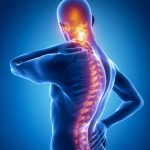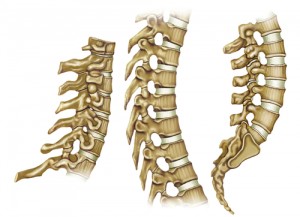 The spine is divided in four segments: The part which forms the neck is called the ‘cervical spine,’ the part which forms the back is called the ‘thoracic spine,’ the part which forms the lower back is called as the ‘lumbar spine’ and the part which forms the bottom and the tail bone is called the ‘sacrum.’
The spine is divided in four segments: The part which forms the neck is called the ‘cervical spine,’ the part which forms the back is called the ‘thoracic spine,’ the part which forms the lower back is called as the ‘lumbar spine’ and the part which forms the bottom and the tail bone is called the ‘sacrum.’
The spine, when seen from the side, is not a straight structure. Rather, it has curves that open in the front or in the back. The spine has double ‘S’ curves and they function to balance our head over the pelvis while doing day to day activities, like standing and sitting. The lumbar lordosis, which is the sway in the lower back, is especially important for upright posture. This sway balances the forward bend of the spine in the chest called a kyphosis. This balance is important for energy economy, which enables a person to carry out his day to day work without undue fatigue or exhaustion.
Diseases affecting the mobile part of the spine, especially the low back or the lumbar spine and sometimes due to degenerative arthritis, affect the lordosis in the spine and may cause scoliosis. Scoliosis is an abnormal curvature of the spine in the third plane. When these deformities exceed the correcting capacity of the normal spine to keep patients balanced or straight, patient start to bend forward when they walk or stand. Their energy expenditure increases for simple tasks and they get exhausted sooner and more often. The spinal imbalance is further expressed in people of increased age, as with increasing age the flexibility goes down and so does the adaptability of the spine.
 In a spine clinic, patients usually present with focal problems and status of the global balance between the curves of the spine is often ignored. Most of the spine surgeries done are more focused on the local factors (e.g. compression and disc degeneration) and the focus is mostly on few levels. Surgeries done for these focal problems may further aggravate the existing imbalance. It is important to maintain the relative motion or the curvature within limits set by the patient’s anatomy. This ignorance may have bearing on bad outcomes in spine surgery. It is important to pay attention to the sway in the back (the “lordosis”) while doing surgery. It is important to preserve or reestablish it to prevent further complications. Any failure to do so may also land up patient with problems at the adjacent levels.
In a spine clinic, patients usually present with focal problems and status of the global balance between the curves of the spine is often ignored. Most of the spine surgeries done are more focused on the local factors (e.g. compression and disc degeneration) and the focus is mostly on few levels. Surgeries done for these focal problems may further aggravate the existing imbalance. It is important to maintain the relative motion or the curvature within limits set by the patient’s anatomy. This ignorance may have bearing on bad outcomes in spine surgery. It is important to pay attention to the sway in the back (the “lordosis”) while doing surgery. It is important to preserve or reestablish it to prevent further complications. Any failure to do so may also land up patient with problems at the adjacent levels.
With time, spine surgeons have realized that a small anatomical part of the spine cannot be looked in isolation. Rather, it has to be looked as globally, especially in terms of its balance. At Prairie Spine & Pain Institute, before discussing any surgical intervention on the spine, the patient’s balance is assessed globally and the limits are set based on the spinal anatomy for further changes in patient curvatures. This approach enables us to deliver better and consistent outcomes, not only in the short term but also long term.
The deformities in the spine may be the root cause of the pain the patient is suffering from. This pain is usually a discomfort like pain, which sets in especially after standing or walking for long periods. Relief from this pain can only be obtained by realigning the spine, either with postural correction or with physical therapy, if the deformity is minimal. If the deformity is moderate to severe, the deformity needs to be corrected surgically. Surgically correcting spinal deformities involves correcting the deforming forces, thus restoring balance and energy economy.


 Dr. Amit Bhandarkar M.B.B.S., M.S., M.D. is a fellowship trained, Orthopedic Spine surgeon. Dr Bhandarkar evaluates and treats a wide variety of spine ailments consistent with his comprehensive spine training.
Dr. Amit Bhandarkar M.B.B.S., M.S., M.D. is a fellowship trained, Orthopedic Spine surgeon. Dr Bhandarkar evaluates and treats a wide variety of spine ailments consistent with his comprehensive spine training.




